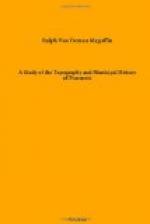The cave to the west is made by Delbrueck the shrine of Iuppiter puer, and the temple with its cave at the east, the aedes Fortunae. This he does on the authority of his understanding of the passage from Cicero which gives nearly all the written information we have on the subject of the temple.[105] Delbrueck bases his entire argument on this passage and two other references to a building called aedes.[106] Now it was Fortuna who was worshipped at Praeneste, and not Jupiter. Although there is an intimate connection between Jupiter and Fortuna at Praeneste, because she was thought of at different times as now the mother and now the daughter of Jupiter, still the weight of evidence will not allow any such importance to be attached to Iuppiter puer as Delbrueck wishes.[107]
The two caves were not made at the same time. This is proved by the fact that the basilica[108] is below and between them. Had there been two caves at the earliest time, with a common precinct as a connection between them, as there was later, there would have been power enough in the priesthood to keep the basilica from occupying the front of the place which would have been the natural spot for a temple or for the imposing facade of a portico. The western cave is the earlier, but it is the earlier not because it was a shrine of Iuppiter puer, but because the ancient road which came through the forum turned up to it, because it is the least symmetrical of the two caves, and because the temple faced it, and did not face the forum.
The various plans of the temple[109] have usually assumed like buildings in front of each cave, and a building, corresponding to the basilica, between them and forming an integral part of the plan. But the basilica does not quite align with the temple, and the road back of the basilica precludes any such idea, not to mention the fact that no building the size of a temple was in front of the west cave. It is the mania for making the temple cover too large a space, and the desire to show that all its parts were exactly balanced on either side, and that this triangular shaped sanctuary culminated in a round temple, this it is that has caused so much trouble with the topography of the city. The temple, as it really is, was larger perhaps than any other in Latium, and certainly as imposing.
Delbrueck did not see that there was a real communication between the caves along the so-called cryptoporticus. There is a window-like hole, now walled up, in the east cave at the top, and it opened out upon the second story of the cryptoporticus, as Marucchi saw.[110] So there was an unseen means of getting from one cave to the other. This probably proves that suppliants at one shrine went to the other and were there convinced of the power of the goddess by seeing the same priest or something which they themselves had offered at the first shrine. It certainly proves that both caves were connected with the rites having to do with the proper obtaining of lots from Fortuna, and that this communication between the caves was unknown to any but the temple servants.




